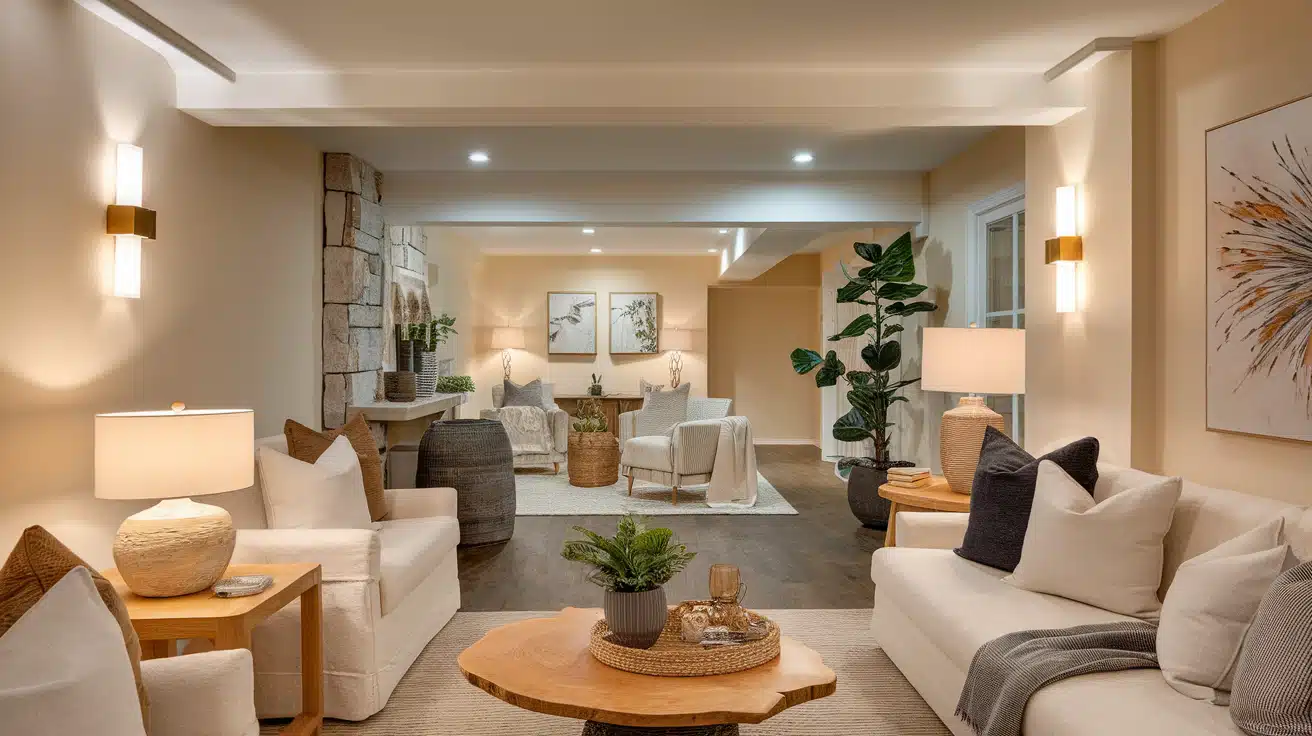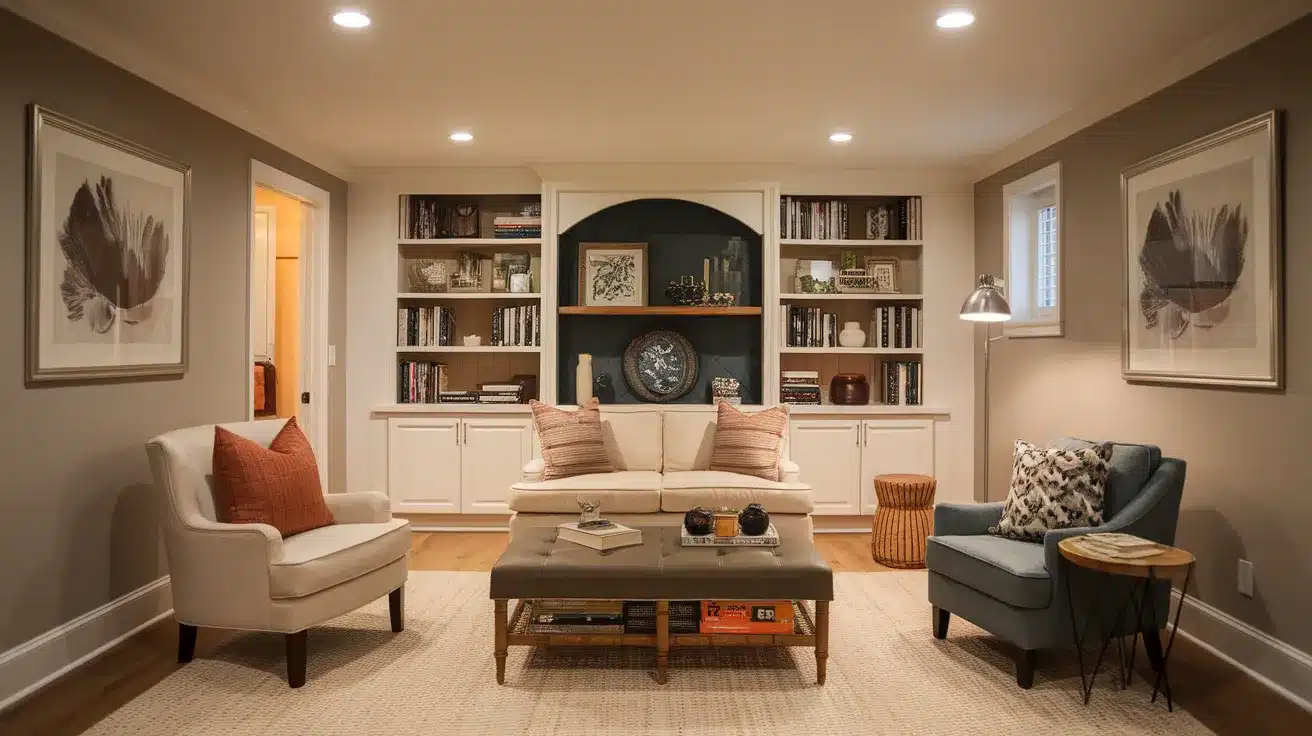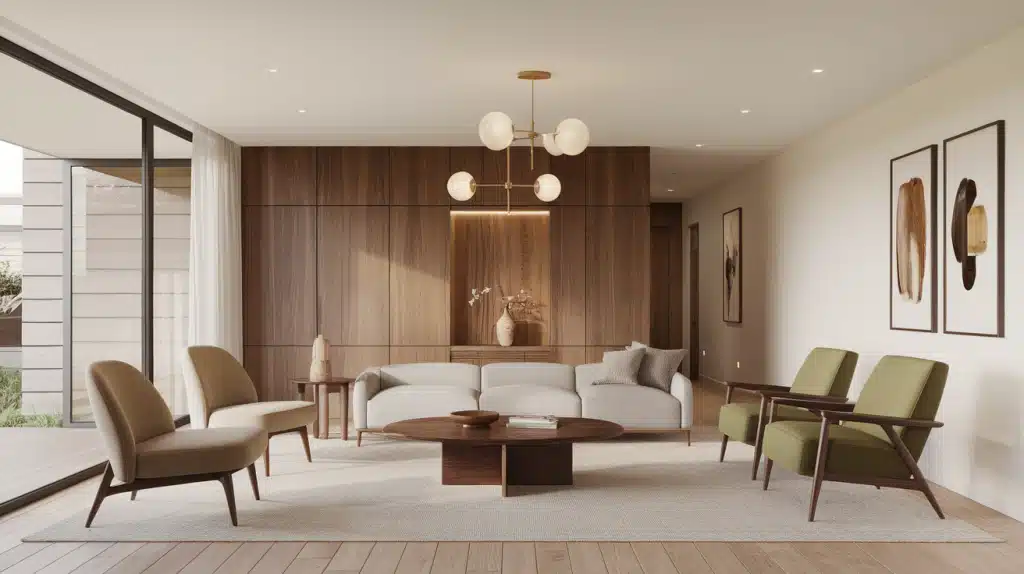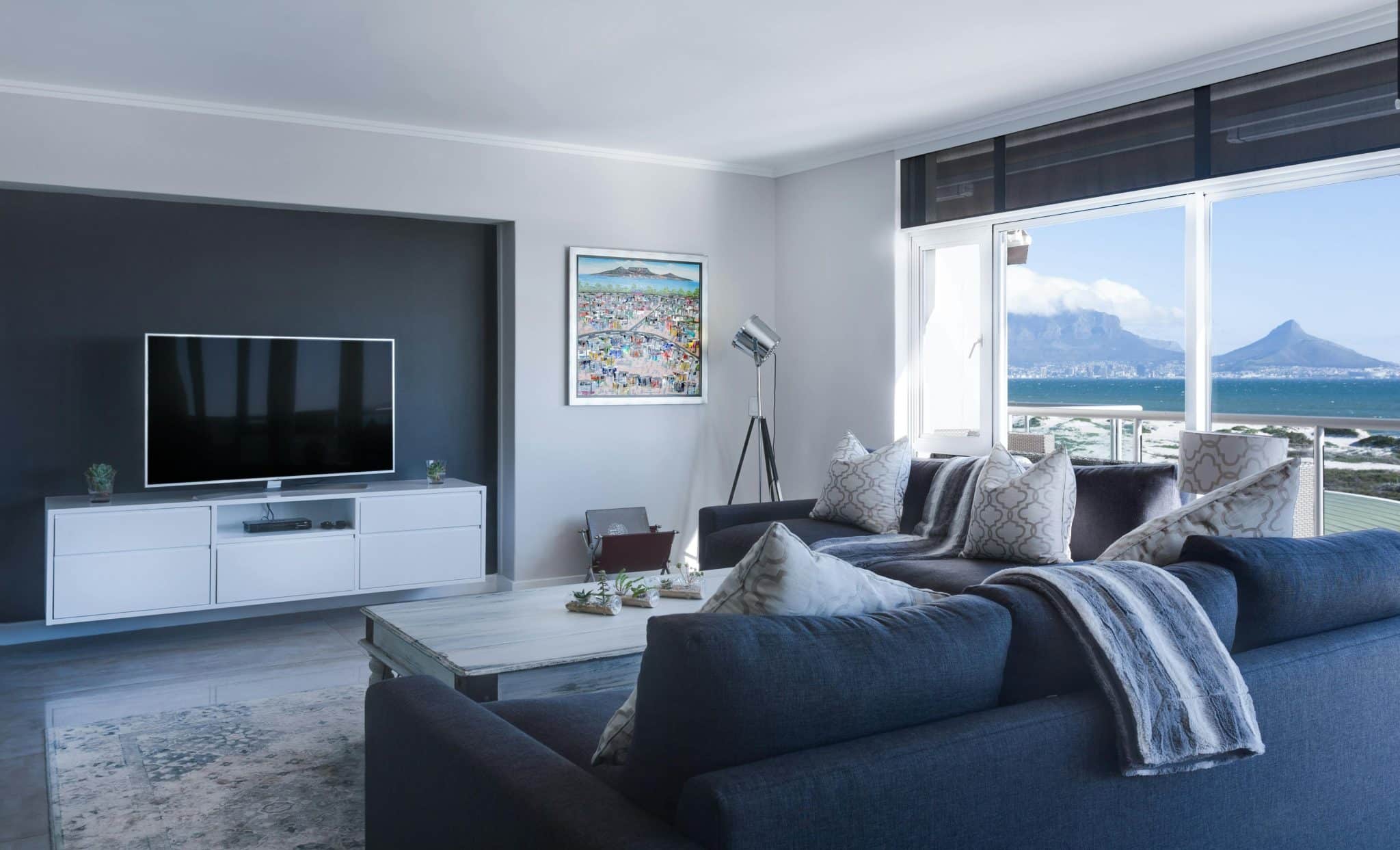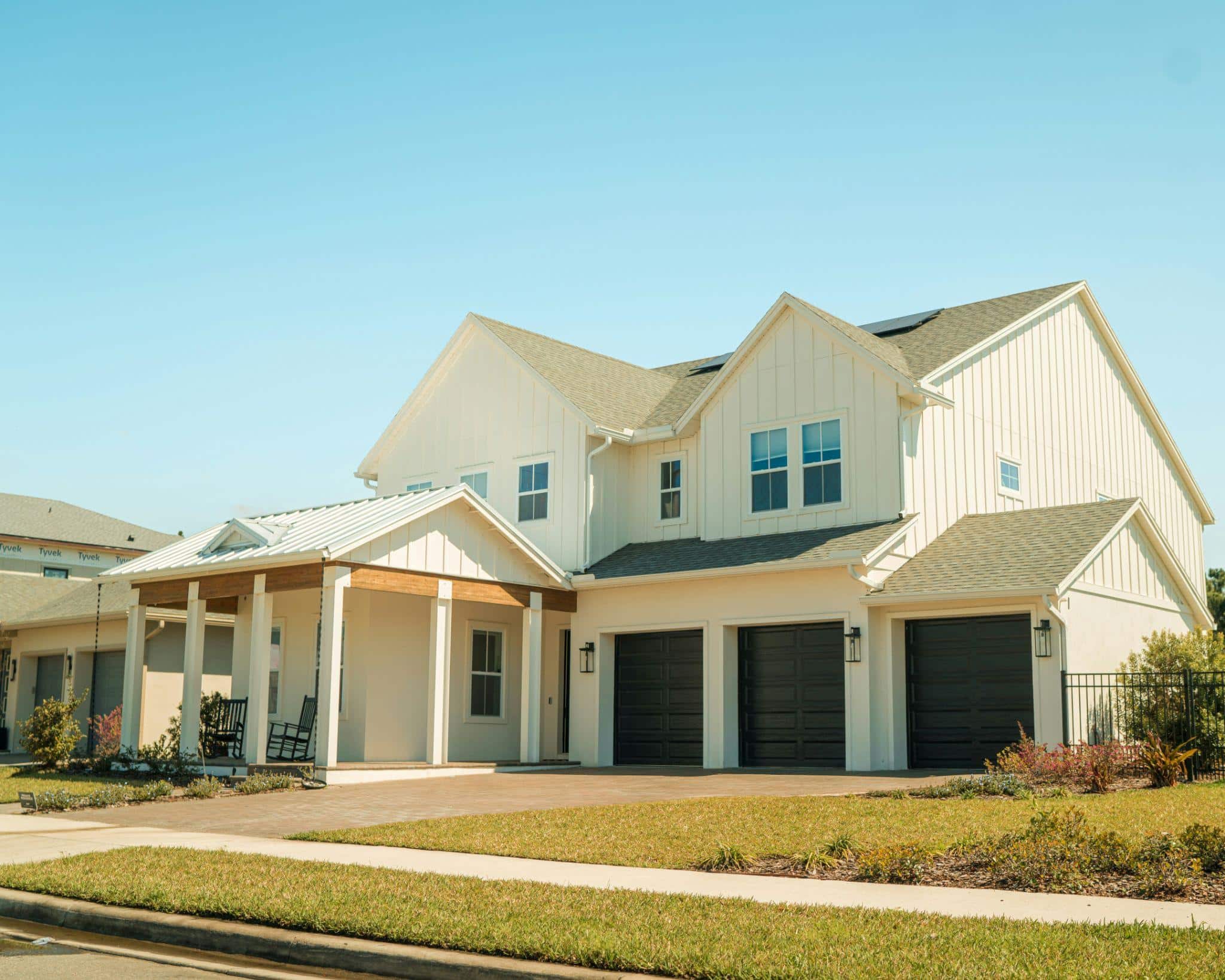For years, my basement sat neglected—a dark storage area collecting dust and forgotten items.
That all changed when I realized the potential hiding beneath my home. With some creativity and planning, I turned my underwhelming basement into my favorite part of the house.
Basements aren’t just concrete boxes anymore—they’re blank canvases waiting for your personal touch. From cozy retreats to functional workspaces, the possibilities are nearly endless.
Ready to make the most of your downstairs space? Let’s look at some ideas that could work for your home too.
Basement Transformation Ideas
These versatile ideas will help you turn an underutilized basement into a functional, beautiful part of your home.
1. Transforming Your Basement into a Cozy Retreat
Creating a calm and comfortable space for relaxation doesn’t have to be complicated. Focus on soft textures, warm colors, and good lighting to make the space inviting.
Design elements for a soothing, cozy environment include soft lighting (think table lamps and wall sconces rather than overhead lights), comfortable seating with plush cushions and throws, and natural materials to add warmth.
2. Maximizing Ceiling Height for Airy Spaces
Even with standard basement heights, you can create the feeling of more space. Paint ceilings white or a light color and use recessed lighting to avoid hanging fixtures that draw the eye down.
If you’re lucky enough to have tall ceilings, consider installing lofted areas for storage or additional living space, high shelving to draw the eyes upward, and vertical storage solutions that don’t take up floor space.
3. Multi-Use Spaces for Modern Lifestyles
Modern homes need flexible spaces that adapt to changing needs. Use zone planning to design your basement to serve multiple functions, creating distinct areas within one large space.
Invest in modular furniture pieces that can be reconfigured and movable partitions or screens that can divide the space when needed but don’t permanently close off areas.
4. Basement as a Home Entertainment Hub
A basement is the perfect spot for a dedicated entertainment area because it’s naturally darker and more sound-insulated than upper floors.
If you’re creating a true theater experience, consider built-in cabinets for media equipment, proper placement of speakers for optimal sound, and comfortable tiered seating.
5. Creating a Basement Dining Area
For smaller homes, adding a dining area in the basement provides extra space for entertaining larger groups or enjoying special meals.
Ideas include built-in bench seating to save space, bar-height tables that create a more casual vibe, and statement pendant lighting to make the area feel special and intentional.
6. Incorporating Natural Materials for Warmth
Basements can feel cold and sterile, but natural materials instantly add warmth and texture to counteract this feeling.
Try wood paneling on accent walls, stone veneer around a fireplace or bar area, and incorporating houseplants to bring life into the space.
7. Industrial Chic Basement Ideas
The exposed structural elements common in basements work perfectly with industrial design. Instead of hiding pipes and beams, make them part of your design.
Balance raw materials like concrete and metal with softer elements—plush rugs, comfortable furniture, and warm lighting—to prevent the space from feeling too harsh.
8. Basement with a Built-In Bar
A basement bar creates a perfect spot for entertaining friends or enjoying evening cocktails without leaving home.
Focus on durable countertop materials that can withstand spills, good task lighting for mixing drinks, and enough storage for glassware and bottles.
9. Unique Lighting Ideas for Basements
Since basements typically have limited natural light, your lighting plan becomes even more crucial than in above-ground spaces.
Create a layered lighting scheme with ambient lighting for overall illumination, task lighting for specific activities, and accent lighting to highlight architectural features or artwork.
10. Walk-In Closets or Dressing Rooms
If bedroom closets upstairs are limited, consider using basement space for a dedicated walk-in closet or dressing area.
Install good lighting (natural daylight bulbs are best for seeing true colors), full-length mirrors, and consider a dehumidifier to protect clothing from basement moisture.
11. Stylish Storage Solutions for Small Spaces
Basements often become default storage areas, but with thoughtful design, storage can be both functional and attractive.
Look for furniture that does double-duty, like ottomans with hidden storage, staircases with built-in drawers, and wall-mounted shelving that keeps items off the floor.
12. Basement Home Library or Reading Corner
The quiet isolation of a basement makes it perfect for a reading retreat away from household noise.
Create the perfect reading nook with comfortable seating, adjustable lighting for reading at different times of day, and acoustical treatments to dampen mechanical noise from furnaces or water heaters.
13. Modern Kitchenette in the Basement
Adding a small kitchen area makes a basement more functional for entertaining or as a separate living space for guests or older children.
For tight spaces, consider compact appliances designed for small kitchens, a single-wall kitchen layout, and open shelving instead of upper cabinets to maintain an airy feel.
14. Flexible Craft or Hobby Room
A dedicated space for hobbies keeps projects contained and allows you to leave works-in-progress without disrupting the rest of the home.
Include plenty of storage for supplies, durable flooring that can handle spills, and strong, adjustable lighting for detail work.
15. Luxury Basement Bathrooms
Adding a bathroom to your basement significantly increases its usability and your home’s value.
Consider a curbless shower for a modern look that’s also accessible, heated flooring to combat the naturally cooler basement temperatures, and good ventilation to prevent moisture issues.
16. Green Basement Design
Incorporating sustainable materials and energy-efficient designs isn’t just for upper floors—basements can be eco-friendly, too.
Consider energy-efficient lighting and appliances, recycled or reclaimed materials for finishes, and non-toxic paints and sealants with low VOC content.
17. Retro Basement Design Ideas
A basement is the perfect place to have fun with design themes that might feel too bold for main living areas.
Create a retro game room with vintage arcade machines, a 50s-style diner area with booth seating, or a 70s-inspired lounge with conversation pits and bold patterns.
18. Smart Technology Integration
Integrated tech makes a basement more comfortable and convenient, especially if it’s a space you use regularly.
Consider smart lighting systems controllable from your phone, programmable thermostats to maintain comfortable temperatures, and wireless audio systems for entertainment.
19. Art-Inspired Basement Spaces
The controlled lighting environment of a basement makes it excellent for displaying art collections.
Install gallery lighting systems with adjustable fixtures, create one feature wall for rotating displays, and consider track lighting that can be redirected as your collection changes.
20. Home Gym Design Ideas
Basements provide the perfect spot for home gyms with their concrete floors and separation from living areas.
Install mirrors to check the form and make the space feel larger. Choose proper flooring for your workout style (rubber mats for weights, wood or vinyl for yoga) and ensure good ventilation.
21. Basement with an Open Bar and Lounge Area
An open-concept bar and lounge create a social hub for entertaining.
Keep sight lines open between areas, use consistent flooring throughout to unify the space, and create distinct zones with area rugs and lighting changes.
22. Using Color to Define Spaces
In open-concept basements, color becomes an important tool for defining different functional areas.
Use consistent base colors throughout with accent colors to define zones, consider painting the ceiling a different color from the walls, and use colorful furniture and textiles as focal points.
23. Basement with a Fireplace
A fireplace creates a natural focal point and adds much-needed warmth to naturally cooler basement spaces.
Consider ventless gas or electric options if running a traditional chimney isn’t practical, create a feature wall around the fireplace with stone or tile, and arrange seating to focus on this warm, inviting element.
24. Incorporating Outdoor Elements in Your Basement
Bring natural elements indoors to make basement spaces feel less subterranean.
Consider a living wall of plants with integrated lighting, a small water feature for ambient sound, and materials typically used outdoors like flagstone or cedar.
25. DIY Basement Design Projects
Even with modest DIY skills, you can transform your basement with weekend projects.
Try painting concrete floors with specialty paint, creating built-in shelving between wall studs, or installing peel-and-stick wallpaper for accent walls.
26. Basement as a Music Studio
The natural sound isolation of a basement makes it ideal for musicians looking to practice or record without disturbing the household.
Invest in proper acoustic treatments to control sound, create dedicated storage for instruments, and consider soundproofing walls and ceilings for serious music production.
27. Basement Bedroom with Custom Furniture
A basement bedroom can be just as comfortable and stylish as an upstairs room with the right approach.
Built-in furniture, such as platform beds with storage drawers, wall-mounted headboards with integrated lighting, and custom closet solutions, maximizes limited space.
28. Bohemian Basement Spaces
A boho basement can be a relaxed, creative space that feels separate from the more structured areas of your home.
Layer rugs for warmth and texture, incorporate a mix of vintage and handmade items, and use natural materials like rattan and macramé for a laid-back, artistic vibe.
29. Using Mirrors to Enhance Basement Design
Mirrors are a basement designer’s best friend—they reflect light, create the illusion of more space, and can add architectural interest.
Place large mirrors opposite any windows to maximize natural light, use mirrored cabinet doors to make storage blend into the background, and try decorative mirrors as art pieces.
30. Outdoor-Inspired Basement Designs
Create a space that feels connected to the outdoors, even when you’re below ground level.
Incorporate materials typically found outside, like stone veneer, cedar planking, or a pebble floor in the bathroom, and maximize any views through window wells or walkout doors.
31. Mid-Century Modern Basement Styles
The clean lines and functional focus of mid-century design work well in basement spaces.
Look for furniture with tapered legs that sits up off the floor, incorporate wood paneling for warmth (but in a modern way), and choose iconic lighting pieces that make a statement.
32. Basement Laundry Room Makeovers
A basement laundry room doesn’t have to be dark and unwelcoming—with some attention, it can be both functional and attractive.
Add good task lighting above work areas, incorporate countertops for folding, and use attractive containers for detergents and supplies that you won’t mind seeing.
33. Basement with Hidden Rooms or Secret Spaces
Adding an element of mystery and surprise with hidden rooms can make your basement extra special.
Consider a bookshelf that’s actually a door, storage cabinets that conceal a small office nook, or a play area hidden behind a sliding panel—functional and fun for both kids and adults.
Tricks for Making Your Basement Feel Larger
- Use large mirrors strategically placed to reflect light and create the illusion of more space.
- Choose furniture with visible legs rather than pieces that sit directly on the floor.
- Install continuous flooring throughout instead of breaking up the space with different materials.
- Keep window treatments minimal on any windows you do have
- Consider glass or acrylic furniture that doesn’t visually take up as much space
- Use vertical space with tall shelving and storage that draws the eye upward
Conclusion
When I look at my basement now compared to what it once was, the transformation continues to amaze me.
This space that used to be just storage has become a place where family memories are made, where friends gather, and where I find daily comfort and function.
The beauty of basement design lies in its flexibility—it can truly be whatever you need it to be.
With thoughtful planning and personal touches, your basement can shift from forgotten square footage to the heart of your home activities.
The ideas we’ve explored offer starting points, but the most successful designs will always be the ones that reflect how you actually live and what makes you feel at home.

